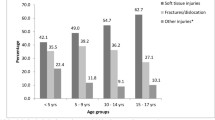Abstract
Introduction
Intentional injuries pose a significant, yet underreported threat to children in sub-Saharan Africa. We sought to evaluate intentional injuries trends and compare outcomes between unintentional and intentional injuries in pediatric patients presenting to a tertiary care facility in Malawi.
Methods
We performed a review of pediatric (≤15 years old) trauma patients presenting to Kamuzu Central Hospital, Lilongwe, Malawi, from 2009 to 2018. Patient characteristics and outcomes were compared based on the injury intent, using bivariate and multivariate regression analysis.
Results
We included 42,600 pediatric trauma patients in the study. Intentional injuries accounted for 5.9% of all injuries. Children with intentional injuries were older (median, 10 vs. 6 years, p < 0.001), more likely to be male (68.4% vs. 63.9%, p < 0.001), and had significantly lower mortality (0.8% vs. 1.4%, p = 0.02) than those with unintentional injuries There was no significant change in the incidence of or mortality associated with intentional injuries. On multivariable regression, increasing age, head and cervical spine injury, night-time presentation, penetrating injury, and alcohol use were associated with increased risk of intentional harm.
Conclusion
Intentional injury remains a significant cause of pediatric trauma in Malawi without decreasing hospital presentation incidence or mortality. In sub-Saharan Africa, there is a need to develop comprehensive plans and policies to protect children.
Level of evidence
II.

Similar content being viewed by others
References
World Health Organization (2006) Child and adolescent injury prevention: a WHO plan of action 2006–2015. World Health Organization. https://apps.who.int/iris/handle/10665/43267
Kendig CE, Samuel JC, Varela C, Msiska N, Kiser MM, McLean SE, Cairns BA, Charles AG (2014) Pediatric surgical care in Lilongwe, Malawi: outcomes and opportunities for improvement. J Trop Pediatr 60(5):352–357. https://doi.org/10.1093/tropej/fmu026
WHO Global Consultation on Violence and Health (1996) Violence: a public health priority. World Health Organization, Geneva
Sergio Pinheiro P (2006) World report on violence against children. United Nations. https://digitallibrary.un.org/record/587334?ln=en
Gallaher JR, Wildfire B, Mabedi C, Cairns BA, Charles AG (2016) Intentional injury against children in Sub-Saharan Africa: a tertiary trauma centre experience. Injury 47(4):837–841. https://doi.org/10.1016/j.injury.2015.10.072
UN Youth. https://www.un.org/en/sections/issues-depth/youth-0/index.html. Accessed 27 April 2020
American Academy of Pediatrics Ages & Stages. https://healthychildren.org/english/ages-stages/pages/default.aspx. Accessed 10 September 2020
Olatunya OS, Isinkaye AO, Oluwadiya KS (2015) Profile of non-accidental childhood injury at a tertiary hospital in south-west Nigeria. J Trop Pediatr 61(3):174–181. https://doi.org/10.1093/tropej/fmv009
Know Violence in Childhood (2017) Ending violence in childhood: global report 2017. New Delhi, India
Ministry of Gender, Children, Disability and Social Welfare of the Republic of Malawi, United Nations Children’s Fund, The Center for Social Research at the University of Malawi, and the Centers for Disease Control and Prevention. Violence against Children and Young Women in Malawi: Findings from a National Survey, 2013. Lilongwe, Malawi: Government of Malawi, 2014.
Devries KM, Allen E, Child JC, Walakira E, Parkes J, Elbourne D, Watts C, Naker D (2013) The good schools toolkit to prevent violence against children in Ugandan primary schools: study protocol for a cluster randomised controlled trial. Trials 14:232. https://doi.org/10.1186/1745-6215-14-232
Livingston JK, Grigorian A, Kuza CM, Lekawa M, Bernal N, Allen A, Nahmias J (2019) Non-accidental trauma increases length of stay and mortality in pediatric trauma. PediatrSurgInt 35(7):779–784. https://doi.org/10.1007/s00383-019-04482-5
Purcell L, Mabedi CE, Gallaher J, Mjuweni S, McLean S, Cairns B, Charles A (2017) Variations in injury characteristics among paediatric patients following trauma: a retrospective descriptive analysis comparing pre-hospital and in-hospital deaths at Kamuzu Central Hospital, Lilongwe, Malawi. Malawi Med J 29(2):146–150. https://doi.org/10.4314/mmj.v29i2.13
Bequele A (2010) Monitoring the commitment and child-friendliness of governments: a new approach from Africa. Child Abuse Negl 34(1):34–44. https://doi.org/10.1016/j.chiabu.2009.08.007
Kempe CH, Silverman FN, Steele BF, Droegemueller W, Silver HK (1962) The battered-child syndrome. JAMA 181:17–24. https://doi.org/10.1001/jama.1962.03050270019004
Pinto L, Lein A, Mahoque R, Wright DW, Sasser SM, Staton CA (2018) A cross-sectional exploratory study of knowledge, attitudes, and practices of emergency health care providers in the assessment of child maltreatment in Maputo, Mozambique. BMC Emerg Med 18(1):11. https://doi.org/10.1186/s12873-018-0162-9
Chesshyre EL, Molyneux EM (2009) Presentation of child sexual abuse cases to Queen Elizabeth Central Hospital following the establishment of an HIV post-exposure prophylaxis programme. Malawi Med J 21(2):54–58. https://doi.org/10.4314/mmj.v21i2.44550
Author information
Authors and Affiliations
Corresponding author
Ethics declarations
Conflicts of interest
The authors declare that they have no conflicts of interest.
Ethical approval
This article does not contain any studies with animals performed by any of the authors. The retrospective review study was in accordance with the ethical standards of the institutional research committee at the University of North Carolina-Chapel Hill and with the 1964 Helsinki Declaration and its later amendments or comparable ethical standards.
Additional information
Publisher's Note
Springer Nature remains neutral with regard to jurisdictional claims in published maps and institutional affiliations.
Rights and permissions
About this article
Cite this article
Akinkuotu, A.C., Purcell, L.N., Kayange, L. et al. Trends and outcomes following intentional injuries in pediatric patients in a resource-limited setting. Pediatr Surg Int 37, 649–657 (2021). https://doi.org/10.1007/s00383-020-04849-z
Accepted:
Published:
Issue Date:
DOI: https://doi.org/10.1007/s00383-020-04849-z




